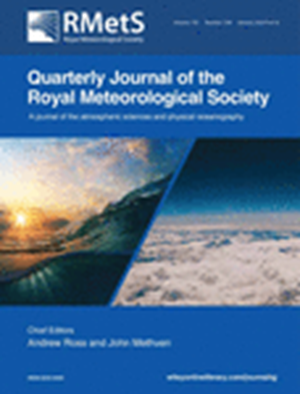气象局对欧洲航天局 Aeolus 卫星水平视线风的业务同化进行评估
IF 2.9
3区 地球科学
Q2 METEOROLOGY & ATMOSPHERIC SCIENCES
引用次数: 0
摘要
欧洲航天局的Aeolus卫星于2018年8月发射,并于2018年9月初开始提供水平视线(HLOS)风观测数据。2019 年初,英国气象局开始评估 HLOS 风是否适合用于其全球数值天气预报系统的业务同化。我们进行了一系列同化实验,以评估 HLOS 风观测对我们全球预报的影响。我们发现,同化 HLOS 风会改变分析区域的带状风,主要是在热带地区和南半球,其中对流层上部和平流层下部的变化最大。这对全球天气预报的准确性产生了积极影响,整个对流层的均方根误差都有所改善。同化 Aeolus HLOS 风改善了几乎所有其他类型观测的观测值减去背景值(6 小时预报)的标准偏差,表明数值天气预报模式分析得到了改善,从而改善了 6 小时预报。在一组短周期观测否认实验中,我们发现同化 Aeolus 的影响程度类似于同化散射计的表面风。雷利信道风同化的影响大约是米氏信道 HLOS 风同化的三倍。因此,我们从 2020 年 12 月开始对米耶信道的风进行业务同化,从 2022 年 5 月开始对雷利信道的风进行业务同化。本文章由计算机程序翻译,如有差异,请以英文原文为准。
Assessment for operational assimilation of horizontal line of sight winds from the European Space Agency's Aeolus at the Met Office
The European Space Agency's Aeolus satellite was launched in August 2018 and began delivering horizontal line‐of‐sight (HLOS) wind observations in early September 2018. In early 2019, the Met Office began assessing the suitability of the HLOS winds for operational assimilation into its global numerical weather prediction system. We performed a number of assimilation experiments to assess the impact of HLOS wind observations on our global forecasts. We have found that assimilating HLOS winds changes the zonal winds in the analysis fields predominantly in the Tropics and Southern Hemisphere, with the largest changes being in the upper troposphere and lower stratosphere. This has a positive impact on the accuracy of the global weather forecasts, with improvements in the root‐mean‐square error seen throughout the troposphere. Assimilation of Aeolus HLOS winds improves the standard deviation of the observation minus background (a 6 hr forecast) of almost all other observation types, suggesting that the numerical weather prediction model analysis is improved, which consequently improves the 6 hr forecast. In a set of short‐period observation denial experiments, we found that assimilating Aeolus has an impact similar in magnitude to assimilating surface winds from scatterometers. Assimilating winds from the Rayleigh channel has approximately three times the impact that assimilating HLOS winds from the Mie channel does. Both channels contribute a measureable improvement to the global forecast, and we therefore started operational assimilation of winds from the Mie channel in December 2020 and the Rayleigh channel operationally in May 2022.
求助全文
通过发布文献求助,成功后即可免费获取论文全文。
去求助
来源期刊
CiteScore
16.80
自引率
4.50%
发文量
163
审稿时长
3-8 weeks
期刊介绍:
The Quarterly Journal of the Royal Meteorological Society is a journal published by the Royal Meteorological Society. It aims to communicate and document new research in the atmospheric sciences and related fields. The journal is considered one of the leading publications in meteorology worldwide. It accepts articles, comprehensive review articles, and comments on published papers. It is published eight times a year, with additional special issues.
The Quarterly Journal has a wide readership of scientists in the atmospheric and related fields. It is indexed and abstracted in various databases, including Advanced Polymers Abstracts, Agricultural Engineering Abstracts, CAB Abstracts, CABDirect, COMPENDEX, CSA Civil Engineering Abstracts, Earthquake Engineering Abstracts, Engineered Materials Abstracts, Science Citation Index, SCOPUS, Web of Science, and more.

 求助内容:
求助内容: 应助结果提醒方式:
应助结果提醒方式:


